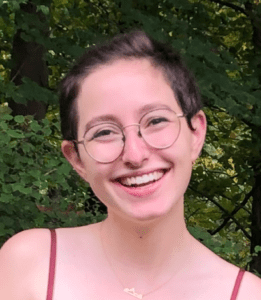Posted By: Sara Cullinan, PhD, Deputy Editor, AJHG

Each month, the editors of The American Journal of Human Genetics interview an author of a recently published paper. This month we check in with Michelle (@mitch_does_sci) to discuss her paper “Familial long-read sequencing increases yield of de novo mutations.”
SC: What prompted you to start working on this project?
MN: I think that de novo mutations (DNMs) are completely fascinating: they can be used to make historical inferences about how our species has evolved over time and they also serve as a lens into how humans are changing right now, which sometimes means that they cause disease. Two former post-docs in our lab selected this family for extensive sequencing, because with Illumina data alone, we weren’t able to identify a causative mutation in the daughter, who is affected with autism. I was so excited to explore the amazing wealth of sequencing data our collaborators generated.
SC: What about this paper/project most excites you?
MN: There were so many exciting aspects of this paper – from the increased number of DNMs we found with HiFi data, to the new regions we could examine when we used the T2T-CHM13 genome as a reference. One of the most exciting parts for me is the number of potential post-zygotic mutations we identified, which was actually something of an accidental finding. In trying to scrape our dataset for any DNMs we might have missed with our filtering pipeline, I stumbled across nearly two dozen variants that were present in Illumina, ONT, and HiFi data in similarly low proportions. These variants didn’t have the normal 3:1 paternal to maternal ratio characteristic of germline DNMs and are likely caused by different mutational mechanisms. I’m eager to identify these types of mutations in more families and to further characterize them.
SC: Thinking about the bigger picture, what implications do you see from this work for the larger human genetics community?
MN: I’ve always seen this as a resource paper – we’ve compiled so many different sequencing technologies and analysis methods and tried them all so you don’t have to. I think this paper is a good jumping off point for people who want to use long-read sequencing to study DNMs. Obviously, not every family can or should be sequenced to this extent, but I think we provide a picture of the relative gains you can get by adding complementary sequencing technologies.
SC: What advice do you have for trainees/young scientists?
MN: Make friends! As a trainee, building and maintaining relationships with other people in my department and on my campus has been crucial for my both my science and my happiness. I think that science is a team sport, so it should fun! To me, one of the biggest skills you can learn is how to find people who you can lean on for support after a hard day, ask for help when you’ve been debugging your code for hours and can’t find the problem, and with whom to celebrate your victories, big and small.
SC: And for fun, tell us something about your life outside of the lab.
MN: Living in Seattle, I’ve become somewhat of a coffee snob! I really enjoy testing out different ways to make coffee, trying out independent cafés around the city, and wrestling with our lab espresso machine!
Michelle Noyes is a graduate student in the Department of Genome Sciences at the University of Washington School of Medicine.
